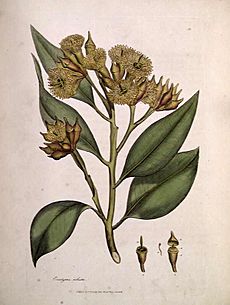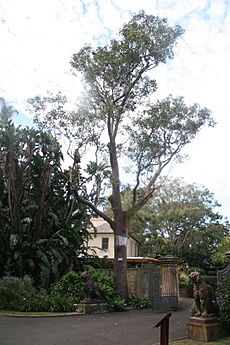Swamp mahogany facts for kids
Quick facts for kids Swamp mahogany |
|
|---|---|
 |
|
| A Swamp Mahogany tree in Haberfield, NSW | |
| Scientific classification | |
| Genus: |
Eucalyptus
|
| Species: |
robusta
|
| Synonyms | |
|
|
The Swamp Mahogany, also called swamp messmate, is a type of tree. Its scientific name is Eucalyptus robusta. This tree grows naturally in eastern Australia. It likes to live in wet, swampy places.
Swamp Mahoganies can grow very tall, up to 30 m (98 ft) high. They have thick, reddish-brown bark that feels spongy. Their leaves are dark green and wide, forming a thick top layer called a canopy. White or cream-colored flowers bloom in autumn and winter. Many insects eat the leaves, and koalas also enjoy them as food. This tree is important because it flowers in winter in eastern Australia. People have planted it in many countries around the world. Its wood is used for firewood and building.
Contents
What the Swamp Mahogany Looks Like
The Swamp Mahogany tree usually grows straight and tall. It can reach about 20–30 metres (70–100 ft) high. Its main trunk can be up to 1 metre (3.3 feet) wide.
The trunk and branches have thick, reddish-brown bark. This bark feels spongy and peels off in long strips. The tree's branches spread out, making a thick, green canopy with its broad leaves.
Leaves, Flowers, and Fruits
The leaves grow one after another along the stems. They are about 10–16 centimetres (3.9–6.3 inches) long and 2.7 to 4.5 cm (1.1 to 1.8 in) wide. Adult leaves are shiny green and shaped like a spear or oval. They have many small veins that look like feathers.
The flowers are white or cream. They grow in groups of 7 to 13 flowers. You can see these flowers from March to September, with the most flowers appearing in May and June. The flower buds are about 2 by 0.8 cm (0.79 by 0.31 in) wide. They have a long, pointed cap, which makes them look like a spindle.
After the flowers, the tree grows woody fruits. These fruits are shaped like cylinders, about 1 to 1.6 cm long and 0.7 to 1.1 cm wide. They hang on small stalks. Inside, the seeds are light brown or yellow, and they are shaped like tiny pyramids.
How it's Different from Similar Trees
The Bangalay tree (E. botryoides) looks a lot like the Swamp Mahogany. However, the Bangalay's flower buds are smaller and shaped like a cone. They also only grow in groups of seven. Its fruits are smaller and do not have stalks.
The name E. robusta comes from the Latin word robustus. This word means "robust" or "strong," which describes how the tree looks.
Tree Names and History

The first people to collect samples of E. robusta were First Fleet surgeon and naturalist John White. This was in the late 1700s. James Edward Smith then wrote the first description of the tree in 1793. He named it robusta because the grown tree is large and strong.
The common name "swamp mahogany" comes from two things. First, it likes to grow in swamps. Second, its wood looks similar to West Indies mahogany. In Queensland, Australia, it is sometimes called "swamp messmate." Other old names include "swamp stringybark," "Gulgong," and "Gnorpin." In the United States, it's called "robusta eucalyptus." In Puerto Rico, it's "beakpod eucalyptus," and in Swahili, it's "mkaratusi."
Family and Relatives
The Swamp Mahogany belongs to a group of eight types of gum trees. These trees have spongy, reddish bark and are known as "red mahoganies." It is closely related to the Bangalay and the Red Mahogany (E. resinifera). You can tell the Swamp Mahogany apart by its larger flowers and fruits. The Red Mahogany usually grows in drier places.
Sometimes, the Swamp Mahogany mixes its genes with other trees. This creates a hybrid tree. For example, it can hybridize with the Forest Red Gum (E. tereticornis). The new tree is then called E. patentinervis. Hybrids have also been seen with other trees like the Flooded Gum and Tasmanian Blue Gum.
Where the Tree Grows
This tree lives in swamps and near river mouths along the coast. It usually grows within a few kilometers of the ocean. You can find it from Rockhampton, Queensland, down to Jervis Bay, New South Wales. It also grows on islands like Great Keppel, Moreton, and Fraser Island.
People have planted Swamp Mahoganies widely for timber. However, in places like Hawaiʻi and Réunion, it has spread too much and is considered an invasive plant. It mostly grows in heavy clay soils. But it can also be found in sandy clay and sandy soils. On islands, it grows in sand.
It grows from sea level up to 50 m (160 ft) high. It prefers swamps or areas where the water table (the level of water underground) is high. This water is usually fresh or slightly salty. Older trees can handle salt, but young trees cannot. The Swamp Mahogany can even grow in very acidic swamp soils.
It is a main tree in swamp forests. It often grows by itself or with other trees like Red Mahogany, Red Bloodwood, and Swamp Sheoak.
Ecology and Wildlife
The Swamp Mahogany is a long-living tree. It can live for at least 200 years. After a bushfire, the trees can grow back from special buds on their trunks.
Many animals use this tree. The grey-headed flying fox eats its flowers. The koala eats its leaves. In some parts of Queensland, the Swamp Mahogany is a very important food source for koalas. The Musk lorikeet drinks nectar from its blossoms. On the New South Wales Central Coast, this tree is important because it is one of the few plants that flowers reliably in winter.
Sadly, many Swamp Mahogany forests have been cleared for development. Some old trees in Robson Park in Sydney are the last remaining ones of their kind in that area.
Insects and Fungi
Many insects eat the leaves of the Swamp Mahogany. These include psyllids and Christmas beetles. One type of psyllid, Glycaspis siliciflava, only eats this tree. Other insects, like scale insects, create galls (small bumps) on the tree. The adult double drummer cicada lives in the tree. Larvae of certain beetles live and grow inside the thick bark.
In Madagascar, where Swamp Mahoganies have been planted, many mushrooms grow around them. Some of these mushrooms are edible and eaten by people. Two types of Russula mushrooms and several types of chanterelle mushrooms are sold in markets. Interestingly, one of these mushrooms, R. prolifica, has only become common in the last 70 years and is not known in Australia.
How People Use Swamp Mahogany
The Swamp Mahogany grows well when people plant it. However, it can get too big for small home gardens. It is often used as a street tree and is good for public areas with wet soil. It can grow very fast and produce many flowers. Some Swamp Mahoganies planted in the Royal Botanic Gardens, Sydney in 1813 are still healthy today.
There is a special type of Swamp Mahogany called E. robusta "Green and Gold." It has leaves with different colors. This type is smaller than the wild tree, growing to about 5–8 metres (16–26 ft) tall.
Plantations and Timber
The Swamp Mahogany is planted widely around the world, from hot areas near the equator to cooler regions. It can handle many different climates and conditions. Because it grows fast and can live in wet soil, it is a very useful tree for planting.
It has been planted in many countries, including Brazil, China, India, Madagascar, South Africa, and the United States (in Hawaii, Florida, and Puerto Rico). People use the wood for firewood and to make charcoal. It is also used to stop soil from washing away, to stabilize sand dunes, and as a shade tree along roads. In Uganda, it is even used to help drain swamps.
Trees in plantations are harvested at different ages for different uses. They might be cut after 4–5 years for fuel wood, 8–10 years for pulp wood, or 30–60 years for logs to be cut into timber.
The wood of the Swamp Mahogany is very strong and lasts a long time. It can even resist worms that live in the ocean. This makes it good for building wharves (docks) and fences. The wood is light reddish-brown and has a rough texture.
Gallery
- Features of the swamp mahogany (Eucalyptus robusta)
See also
 In Spanish: Eucalipto robusto para niños
In Spanish: Eucalipto robusto para niños









